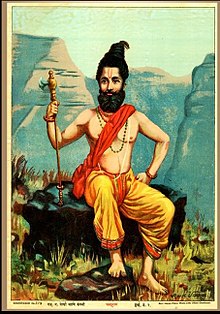Parashurama
Parashurama (Sanskrit: परशुराम, IAST: Paraśurāma, lit. Rama with an axe) is the sixth avatar of Vishnu in Hinduism. Born as a brahmin, Parashurama carried traits of a Kshatriya and is often regarded as a Brahmin-Kshatriya. He carried a number of Kshatriya traits, which included aggression, warfare and valor; also, serenity, prudence and patience. He, along with only Hanuman and Indrajita, is considered to be one of the very few Atimaharathi warriors ever born on Earth. Like other incarnations of Vishnu, he was foretold to appear at a time when overwhelming evil prevailed on earth. The Kshatriya class, with weapons and power, had begun to abuse their power, take what belonged to others by force and tyrannize people. Parashurama corrects the cosmic equilibrium by destroying these Kshatriya warriors.
He is also referred to as Rama Jamadagnya, Rama Bhargava and Veerarama in some Hindu texts. He is worshipped as the mool (primordial) purusha by Niyogi Bhumihar Brahmin, Chitpavan Brahmin, Tyagi, Mohyals, Anavil and Nambudiri Brahmin communities. According to Hindu legends, Parashurama was born to a Brahmin sage Jamadagni and his wife Renuka, living in a hut. They have a celestial cow called Surabhi which gives all they desire (such a cow is known as kamdhenu)..A king named Kartavirya Arjuna (not to be confused with Arjuna the Pandava)[5][note 1] – learns about it and wants it. He asks Jamadagni to give it to him, but the sage refuses. While Parashurama is away from the hut, the king takes it by force.Parashurama learns about this crime, and is upset. With his axe in his hand, he challenges the king to battle. They fight, and Parushama kills the king, according to the Hindu History.The warrior class challenges him, and he kills all his challengers. The legend likely has roots in the ancient conflict between the Brahmin varna (class), with religious duties, and the Kshatriya varna, with warrior and enforcement roles.
In some versions of the legend, after his martial exploits, Parashurama returns to his sage father with the Surabhi cow and tells him about the battles he had to fight. The sage does not congratulate Parashurama, but reprimands him stating that a Brahmin should never kill a king. He asks him to expiate his sin by going on pilgrimage. After Parashurama returns from pilgrimage, he is told that while he was away, his father was killed by warriors seeking revenge. Parashurama again picks up his axe and kills many warriors in retaliation. In the end, he relinquishes his weapons and takes up Yoga.
In Kannada folklore, especially in devotional songs sung by the Devdasis he is often referred to as son of Yellamma.
Parasurama legends are notable for their discussion of violence, the cycles of retaliations, the impulse of krodha (anger), the inappropriateness of krodha, and repentance. According to Madeleine Biardeau, Parasurama is a mythical character constructed in ancient Hindu thought as a fusion of contradictions, possibly to emphasize the ease with which those with military power tend to abuse it, and the moral issues in circumstances and one's actions, particularly violent ones.
Texts
He is generally presented as the fifth son of Renuka and rishi (seer) Jamadagni, states Thomas E Donaldson.[6] The legends of Parashurama appear in many Hindu texts, in different versions
- In chapter 3.33 of the Mahabharata, he is the grandson of Satyavati, and the son of princess Renuka after she marries a Vedic scholar living in a forest.
- In chapter 6 of the Devi Bhagavata Purana, he is born from the thigh with intense light surrounding him that blinds all warriors, who then repent their evil ways and promise to lead a moral life if their eyesight is restored. The boy grants them the boon.
- In chapter 4 of the Vishnu Purana, Rcika prepares a meal for two women, one simple, and another with ingredients that if eaten would cause the woman to conceive a son with martial powers. The latter is accidentally eaten by Renuka, and she then gives birth to Parashurama.
- In chapter 2 of the Vayu Purana, he is born after his mother Renuka eats a sacrificial offering made to both Rudra (Shiva) and Vishnu, which gives him dual characteristics of Kshatriya and Brahmin.
He plays important roles in the Mahabharata serving as mentor to Bhishma (chapter 5.178), Drona (chapter 1.121) and Karna (chapter 3.286), teaching weapon arts and helping key warriors in both sides of the war.
In the Mahabharata, he is the teacher of warrior Karna. In the regional literature of Kerala, he is the founder of the land, the one who brought it out of the sea and settled a Hindu community there. He is also known as Rama Jamadagnya and Rama Bhargava in some Hindu texts. Parashurama retired in the Mahendra Mountains, according to chapter 2.3.47 of the Bhagavata Purana. He is the only Vishnu avatar who never dies, never returns to abstract Vishnu and lives in meditative retirement.Further, he is the only Vishnu avatar that co-exists with other Vishnu avatars Rama and Krishna in some versions of the Ramayana and Mahabharata respectively.
Parashurama, Sixth Avatar of Vishnu
Parashurama Kshetras
The region of Konkan is considered as Parashurama Kshetra.The ancient Saptakonkana is a slightly larger region described in the Sahyadrikhanda which refers to it as Parashuramakshetra (Sanskrit for "the area of Parashurama") ,Vapi to Tapi is an area of South Gujarat, India. The area blessed by Lord Parshuram and called "Parshuram ni bhoomi".
There is a Parshuram Kund, a Hindu pilgrimage centre in Lohit district of Arunachal Pradesh which is dedicated to the sage Parashurama. Thousands of pilgrims visit the place in winter every year, especially on the Makar Sankranti day for a holy dip in the sacred kund which is believed to wash away one's sins

No comments:
Post a Comment